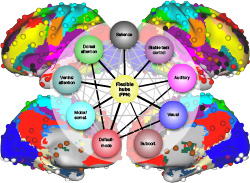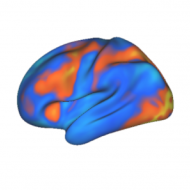 I’m excited to announce that my latest scientific publication – “Multi-task connectivity reveals flexible hubs for adaptive task control” – was just published in Nature Neuroscience. The paper reports on a project I (along with my co-authors) have been working on for over a year. The goal was to use network science to better understand how human intelligence happens in the brain – specifically, our ability to rapidly adapt to new circumstances, as when learning to perform a task for the first time (e.g., how to use new technology).
I’m excited to announce that my latest scientific publication – “Multi-task connectivity reveals flexible hubs for adaptive task control” – was just published in Nature Neuroscience. The paper reports on a project I (along with my co-authors) have been working on for over a year. The goal was to use network science to better understand how human intelligence happens in the brain – specifically, our ability to rapidly adapt to new circumstances, as when learning to perform a task for the first time (e.g., how to use new technology).
The project built on our previous finding (from last year) showing that the amount of connectivity of a well-connected “hub” brain region in prefrontal cortex is linked to human intelligence. That study suggested (indirectly) that there may be hub regions that are flexible – capable of dynamically updating what brain regions they communicate with depending on the current goal.
Typical methods were not capable of more directly testing this hypothesis, however, so we took the latest functional connectivity approaches and pushed the limit, going well beyond the previous paper and what others have done in this area. The key innovation was to look at how functional connectivity changes across dozens of distinct task states (specifically, 64 tasks per participant). This allowed us to look for flexible hubs in the fronto-parietal brain network.
We found that this network contained regions that updated their global pattern of functional connectivity (i.e., inter-regional correlations) depending on which task was being performed.
In other words, the fronto-parietal network changed its brain-wide functional connectivity more than any other major brain network, and this updating appeared to code which task was being performed.
What’s the significance?
These results suggest a potential mechanism for adaptive cognitive abilities in humans:
Prefrontal and parietal cortices form a network with extensive connections projecting to other functionally specialized networks throughout the brain. Incoming instructions activate component representations – coded as neuronal ensembles with unique connectivity patterns – that produce a unique global connectivity pattern throughout the brain. Since these component representations are interchangeable it’s possible to implement combinations of instructions never seen before, allowing for rapid learning of new tasks from instructions.
Important points not mentioned or not emphasized in the journal article:
This study was highly hypothesis-driven, as it tested some predictions of our recent compositional theory of prefrontal cortex function (extended to include parietal cortex as well). That theory was first proposed earlier this year in Cole, Laurent, & Stocco (2013).
Also, as described in our online supplemental FAQ for the paper, we identified ‘adaptive task control’ flexible hubs, but there may be other kinds of flexible hubs in the brain. For instance, there may be flexible hubs for stable task control (maintaining task information via connectivity patterns over extended periods of time, only updating when necessary).
See our online supplemental FAQ for more important points that were not mentioned in the journal article. Additional information is also available from a press release from Washington University.
–MWCole
